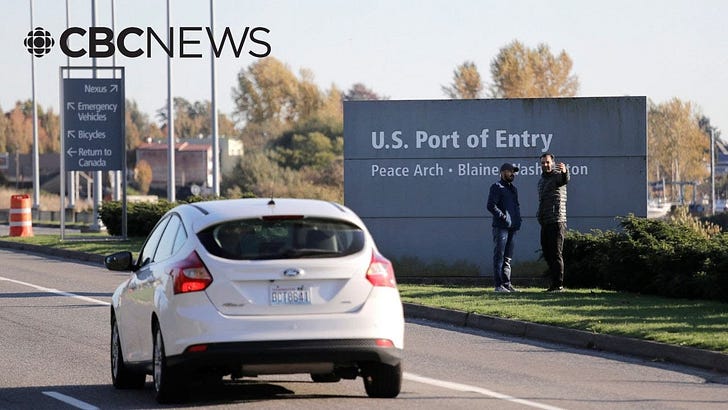Trump Tariff Threats on Canada and Mexico
As Christian Leuprecht, political science professor at Queen's University and Royal Military College, said "Canada had four years to secure the border."
By Chuck Warren
President Donald Trump has been using tariffs on Canada and Mexico as a baton to get these neighbors to the table and protect America's security and national interests. Here are some facts on how North American trade works:
NAFTA (North American Free Trade Agreement) governed North American trade between 1994 and 2020, when President Trump signed the U.S.–Mexico–Canada Agreement (known as USMCA) into law, replacing NAFTA.
Under USMCA, all tariffs are reduced to zero until imports reach a certain quota.
For example, the current annual quota for exports to Canada is 6,250 metric tons for cheese, 4,500 metric tons for butter, and 57,000 metric tons for chicken. As long as American and Mexican exports to Canada remain under these numbers, there would be no tariffs. But once they pass them, tariffs kick in.
This is not just with Canada. The United States and Mexico also have our own quota numbers for imports from within North America.
When these quotas are reached, the governments of the United States, Canada, and Mexico begin imposing tariffs on further imports, and these rates are all over the place. These are called over-quota tariffs.
For example, the Canadian over-quota tariff for cars is 25%, but it is nearly 300% for butter. And there is everything in between.
And every single good has its own separate quota, from oil and gas to beef and pork to broomsticks.
U.S. over-quota tariffs are also all over the place. For instance, if aluminum imports surpass the monthly quota, then the United States imposes a retroactive 10% tariff on all aluminum imports from Canada. This includes the imports made before the quota was reached.
Then, for tobacco over-quota imports, the United States imposes a tariff of 350%.
This is also true of Mexico, which has over-quota tariffs all over the place.
All of these are allowed under the USMCA, which President Trump negotiated and signed. However, right after the USMCA came into effect, Canada tried to cheat. The Biden administration sued Canada for manipulating its quota numbers at the World Trade Organization and won, and Canada backed off.
The tariffs President Trump announced were different. These were blanket 25% tariffs (10% for energy imports) before the quotas were met—and then additional tariffs would kick in once imports exceed these quotas.
This new policy would violate USMCA, but the White House said those were not traditional tariffs to generate revenue or protect domestic production. Rather, the administration intended to use tariffs as a diplomatic tool.
The White House press release mentioned illegal immigration through the border with Mexico and drug smuggling, including fentanyl, through both the northern and southern borders. According to the White House, the governments of Canada and Mexico aren’t doing enough to fix these problems. Therefore, President Trump is using tariffs to force them to.
The White House mentioned:
While trade accounts for 67% of Canada’s GDP, 73% of Mexico’s GDP, it accounts for only 24% of U.S. GDP. However, in 2023 the U.S. trade deficit in goods was the world’s largest at over $1 trillion.
In other words, these tariffs would hurt them much more than us, and they would force them to adjust their behaviors. And it looks like he was right.
This past Monday, the White House announced that tariffs were halted for 30 days. After speaking with his Canadian and Mexican counterparts, all sides agreed to wait. The leaders of Canada and Mexico promised to do more on border security from their sides over the next 30 days, at which point President Trump will be able to judge whether those measures have been enough to give them a stay of execution by tariffs.
Trudeau tweeted that he “is implementing our $1.3 billion border plan — reinforcing the border with new choppers, technology, and personnel, enhanced coordination with our American partners, and increased resources to stop the flow of fentanyl.”
President Claudia Sheinbaum of Mexico also said in a press conference that her administration would be working to stop the movement of cartels through the U.S.–Mexico border.
President Trump also said that he looks forward to working with both governments and his counterparts to fix our border problems.
Many on the left are mocking Trump for getting nothing in exchange for canceling his tariff plans. They say that Canada and Mexico had already pledged to take these measures on border security. This is a half-truth.
Canada announced these plans late in 2024 after Trump was re-elected, precisely because it feared Trump’s tariff plan. Mexico also already had troops at the border but promised to deploy more—and already has begun to send more military personnel to the border.
The whole truth is that Mexico has added to its plans to secure the border because of Trump’s threats, and Canada has pledged that it is now moving even more quickly with its plan because of Trump’s threat of tariffs on Sunday.
As Christian Leuprecht, political science professor at Queen's University and Royal Military College, said "U.S. President Donald Trump's border concerns about migrants and drugs aren't new, but Canada failed to address them for political reasons ... Canada had four years to secure the border."
Hence, Trump, realizing talk is cheap brought his bully pulpit and baton to get them to keep their promises.
If things go as they look right now, we will get secure borders on both sides and no tariffs. What’s not to love?
Note: the opinions expressed herein are those of Chuck Warren only and not his co-host Sam Stone or Breaking Battlegrounds’ staff.





